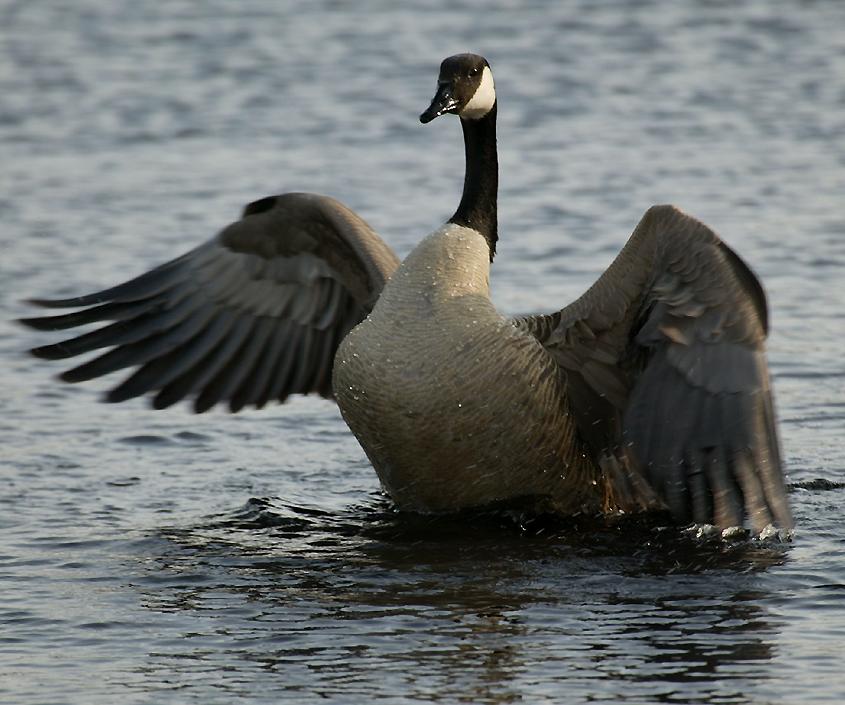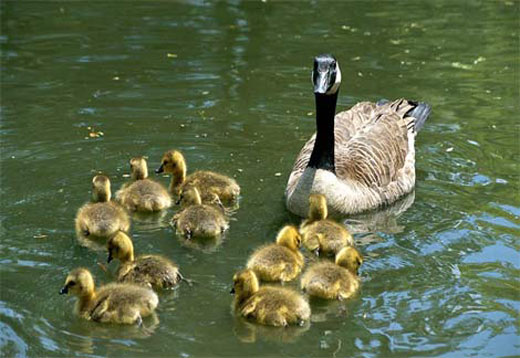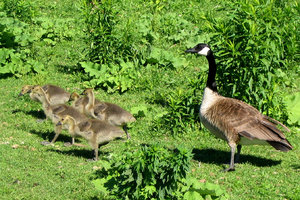 The Canada Goose (Branta canadensis) is a wild goose belonging to the genus Branta, which is native to arctic and temperate regions of North America, having a black head and neck, white patches on the face, and a brownish-gray body.
The Canada Goose (Branta canadensis) is a wild goose belonging to the genus Branta, which is native to arctic and temperate regions of North America, having a black head and neck, white patches on the face, and a brownish-gray body.The Canada Goose was one of the many species described by Carl Linnaeus in his 18th-century work Systema Naturae. It belongs to theBranta genus of geese, which contains species with largely black plumage, distinguishing them from the grey species of the Anser genus. The specific epithet canadensis is a New Latin word meaning "from Canada". According to the Oxford English Dictionary, the first citation for the 'Canada Goose' dates back to 1772. The Cackling Goose was formerly considered to be a set of subspecies of the Canada Goose. The Canada Goose is also referred to as the Canadian Goose.
HERE ARE SOME CANADA GOOSE BREEDS.
- Atlantic Canada Goose, Branta canadensis canadensis
- Interior Canada Goose, Branta canadensis interior
- Giant Canada Goose, Branta canadensis maxima
- Moffitt's Canada Goose, Branta canadensis moffitti
- Vancouver Canada Goose, Branta canadensis fulva
- Dusky Canada Goose, Branta canadensis occidentalis
- part of "Lesser complex", Branta canadensis parvipe
This species is native to North America. It breeds in Canada and thenorthern United States in a variety of habitats. Its nest is usually located in an elevated area near water such as streams, lakes, ponds and sometimes on a beaver lodge. Its eggs are laid in a shallow depression lined with plant material and down. The Great Lakes region maintains a very large population of Canada Geese.
 |
| FLYING V- SHAPE,SEE THE BEAUTY! |
Canada Geese are primarily herbivores, although they sometimes eat small insects and fish. Their diet includes green vegetation and grains. The Canada Goose eats a variety of grasses when on land. It feeds by grasping a blade of grass with the bill, then tearing it with a jerk of the head. The Canada Goose also eats grains such as wheat, beans, rice, and corn when they are available.
During the second year of their lives, Canada Geese find a mate. They are monogamous, and most couples stay together all of their lives.If one is killed, the other may find a new mate. The female lays 3–8 eggs and both parents protect the nest while the eggs incubate, but the female spends more time at the nest than the male.[
Known egg predators include coyotes, Arctic Foxes, Northern Raccoons, Red Foxes, large gulls, Common Raven, American Crows and bears.
 |
| BABIES SWIMMING CLOSE TO THEIR MOTHER. |
The incubation period, in which the female incubates while the male remains nearby, lasts for 24–28 days after laying. As the annual summer molt also takes place during the breeding season, the adults lose their flight feathers for 20–40 days, regaining flight at about the same time as their goslings start to fly.
 |
| HAVING A WALK . |
Adult geese are often seen leading their goslings in a line, usually with one parent at the front, and the other at the back. While protecting their goslings, parents often violently chase away nearby creatures, from small blackbirds to lone humans that approach, after warning them by giving off a hissing sound and will then attack with bites and slaps of the wings if the threat does not retreat or has seized a gosling. Most of the species that prey on eggs will also take a gosling. Although parents are hostile to unfamiliar geese, they may form groups of a number of goslings and a few adults, called crèches.
 |
| RESTING IN A POND DURING SPRING MIGRATION! |
The offspring enter the fledging stage any time from 6 to 9 weeks of age. They do not leave their parents until after the spring migration, when they return to their birthplace. Once they reach adulthood, Canada Geese are rarely preyed on, but (beyond humans) can be taken by Coyotes, Red Foxes, Gray Wolves, Snowy Owls, Great Horned Owls, Golden Eagles and, most often, Bald Eagles.
Canada geese are known for their seasonal migrations. Most Canada Geese have staging or resting areas where they join up with others. Their autumn migration can be seen from September to the beginning of November. The early migrants have a tendency to spend less time at rest stops and go through the migration a lot faster. The later birds usually spend more time at rest stops. These geese are also renowned for their V-shaped flight formation. The front position is rotated since flying in front consumes the most energy. Canada Geese leave the winter grounds more quickly than the summer grounds. Elevated thyroid hormones, such as T3 and T4, have been measured in geese just after a big migration. This is believed because of the long days of flying in migration the thyroid gland sends out more T4 which will help the body cope with the longer journey. The increased T4 levels are also associated with increased muscle mass (hypertrophy) of the breast muscle, also because of the longer time spent flying. It is believed that the body sends out more T4 to help the goose's body with this long task by speeding up the metabolism and temperature at which the body works.Also, other studies done show corticosterone levels to rise dramatically in these birds after and during a migration. Corticosterone is known a stress hormone, so it only makes sense that when these birds are stressed by flying long distances everyday, that more corticosterone is released into their system. It is believed that a higher level of corticosterone will help the birds better manage this task.
No comments:
Post a Comment